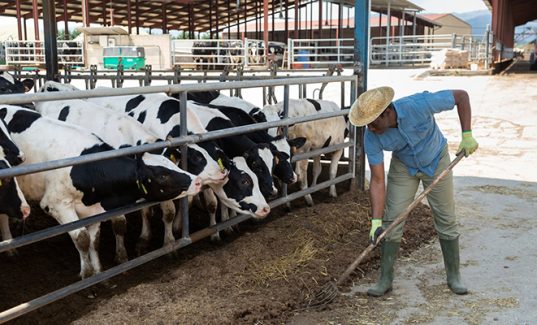Cross-breed cows are mostly associated with extensive systems, but Italian and UK farmers are seeing their benefits in high output systems. Karen Wright reports.
The Holstein breed dominates Italy’s Po Valley with its vibrant milk co-ops and cheese manufacturers, however, crossbreeding is gaining increasing interest in the area south of Milan.
Holsteins have long been bred for high production and good quality milk, mainly derived from maize silage, dried or ensiled ryegrass and lucerne with high protein additions to the total mixed ration.
But more recently, these die-hard dairy producers are looking at other dairy breeds that can look good, milk well and bring the added benefit of better fertility and longevity.
“I had producers who chased me down the road when I suggested using Norwegian Red bulls to improve cow strength and fertility,” says Geno Italy’s technical adviser Dario Pasetti. “Eventually they tried just a few and now they’re calling me back.”
Dr Pasetti, a qualified vet who has worked in the cattle breeding industry in the USA and Italy for the past 25 years, is seeing more producers in this traditionally Holstein heartland crossing their black and white cows with another breed.
“They are looking for more profitable cows – better fertility and longevity without compromising milk,” he says. “The Norwegian Red has given them this. Even the F1 has brought significant improvements in cow strength, fertility and longevity.”
After that, producers can look again and decide which breed might best suit their system. “There are choices – perhaps the Norwegian Red again or a third cross – or back to the Holstein. There is lots of flexibility to suit the system. The herd can keep improving and benefit from other breeds.
Ernesto Fasoli started crossing some of his 130 Holsteins with Norwegian Red seven years ago, mainly to improve his herd’s health characteristics. Despite average yields of 10,000 litres, he wasn’t happy with cell counts of 180,000/ml and fertility – the calving interval was 420 days.
He now uses Norwegian Red sires across the whole herd and is considering a three way cross with the Fleckvieh. Yields have not been affected since introducing the cross-bred cows. The herd 305-day average is 9,762kg at 3.8% protein and 4% fat in with a calving interval of 390 days.
Days open has fallen from 140 days to 110 days and they are now using 1.7 straws of semen a pregnancy compared with 2.5.
But it’s the health benefits that are coming to the fore on Ernesto’s 35ha farm that he runs with his brother and the two sons Nicolas and Simone. “I immediately liked the improved feet, fertility and disease resistance that came with the Norwegian Cross cows. And that meant better longevity,” he says.
“And as time passes, the disease resistance – or health – aspects become more evident. We hardly ever have any retained cleansings and cell counts remain low – typically under 140,000/ml.”
UK perspective on cross-bred cows
North Devon producer Richard Knapman is running a more traditional high output dairy system with his cross-bred herd.
Faced with only 22ha of the 202ha on the dairy unit side of a main road, he decided to house high-yielding cows for more of the year in this autumn calving herd.
“We now keep anything giving more than 30 litres inside up to 200 days into their lactation. Then we start turning them out during the day and by drying off, they will be outdoors full time.”
This change has not affected yields or milk quality of this herd, which is now more than 50% Norwegian Red cross Holstein with a few Fleckvieh cross heifers.
Based on a maize and grass silage TMR with crimped wheat and a Mole Valley blend, he now feeds for 36 litres of milk. This diet change played a part in his herd achieving a record average of 10,300kg in September 2014, up from 8,900kg a year before.
“The cross-bred cows perform just as well in a more intensive system,” he adds. “You might lose a bit of milk with heifers – maybe 200kg, but I have sixth lactation cross-breds giving 13,000kg so they more than make up for it. I rarely have a sixth lactation Holstein in the herd even to compare yields at this stage.”
He has also seen heat detection and milk quality benefits. “They show great signs of bulling – you would struggle to miss a cross-bred cow on heat. This has improved our pregnancy rate, now at 28% for the whole herd, compared with a national average of about 19%.
Milk quality is certainly better. “Even if we don’t feed for constituents, the cross-bred averages 4.2% fat and 3.3% protein while our Holsteins averaged 3.7% fat and 3.1% protein.”
By Karen Wright




